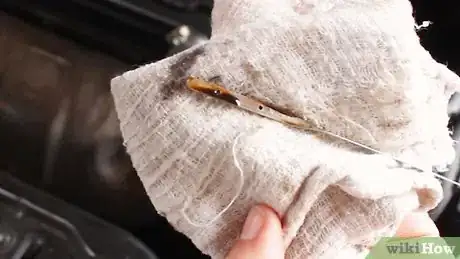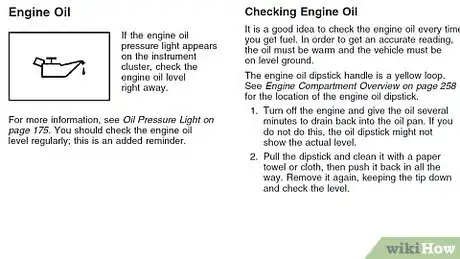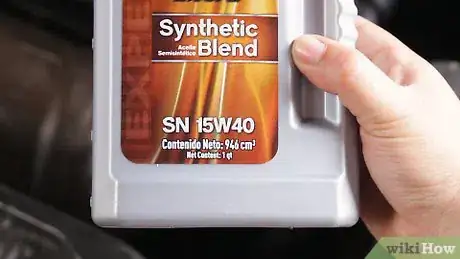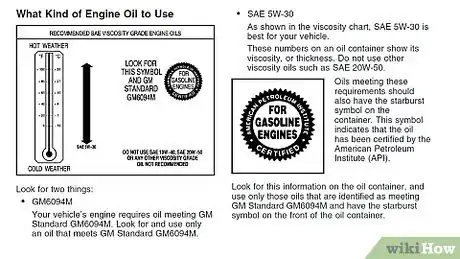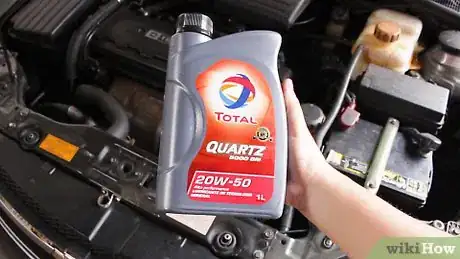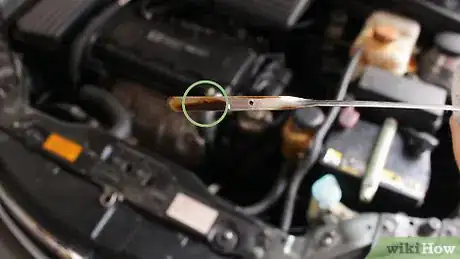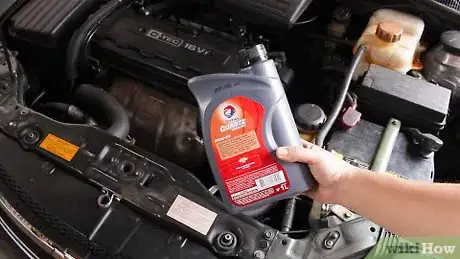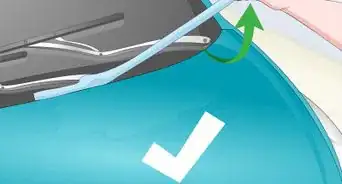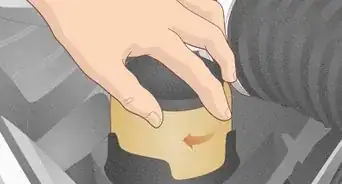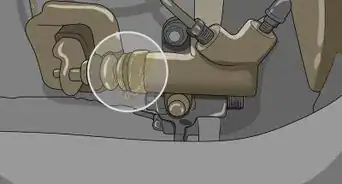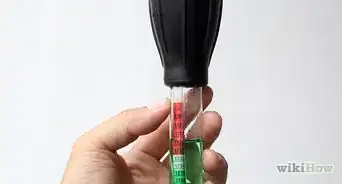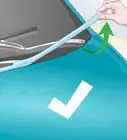This article was co-authored by Tom Eisenberg. Tom Eisenberg is the Owner and General Manager of West Coast Tires & Service in Los Angeles, California, a family-owned AAA-approved and certified auto shop. Tom has over 10 years of experience in the auto industry. Modern Tire Dealer Magazine voted his shop one of the Best 10 Operations in the Country.
There are 10 references cited in this article, which can be found at the bottom of the page.
This article has been viewed 768,169 times.
The oil that runs through your vehicle's engine helps cool down all of its moving parts.[1] You can save yourself a couple of bucks by changing the oil in your car yourself. While all vehicles are a little different, adding oil is something anyone can do with a little eye for detail and a willingness to get dirty. Adding oil, however, is not a substitute for getting your oil changed.
Things You Should Know
- Check oil after the car rests for 5 minutes by popping the hood and pulling out the car’s dipstick. Wipe it off, then reinsert it and pull it out to check your oil.
- Use the oil recommended in the car owner’s manual. Synthetic oils are best for high-end cars, and switching oil types is bad for old cars.
- Pop the hood of the car, locate the oil fill port, and add oil to the reservoir using the dipstick as an indicator of how much to use.
Steps
Checking Your Oil
-
1Check the oil after the car has rested for 5 minutes. If you check the oil right after turning the car off you will get an inaccurate reading, as some of the oil will still be at the top of the engine. Keep the car on a level, even surface as well to make sure you aren't checking the oil on a slant.[2]
- Most auto manufacturers require you check the oil after the car has been warmed by starting it in place for 3-5 minutes. Check your owner's manual if there is any doubt.[3]
- To be safe, you should check your oil every month, and more frequently if you have to drive long distances.
-
2Pop the hood of the car. Usually you need to pull a small lever or press a button near the driver's seat to unlock the hood. From there, run your hand between the hood and the body of the car until you find a small lever, usually in the middle of the hood, and press it inward to completely free the hood.Advertisement
-
3Locate the car's dipstick. This small, usually yellow cap with a loop is often labeled "Engine Oil," but even if it is not it is not difficult to find. The dipstick is a long piece of metal that extends down a tube to the oil pan, telling you, based on how high the oil line is, how much oil is in the engine. It is nearly close to the front of the car, and has a brightly colored circular or hook-shaped handle that you can use to pull out the stick without touching any oil.[4]
-
4Pull out the dipstick and wipe it down with a dry cloth. Oil from the engine will spurt up on the dipstick when the car is running, meaning you should clean it and reinsert it to get an accurate reading. Note the marks near the middle or bottom of the stick, often dots, lines, cross-hatched squares, or bends in the stick. The highest mark is the "Full Line," and your oil should be somewhere between the two lines.[5]
-
5Reinsert the dipstick and pull it out to check your oil. This time you should note where the oil is on the stick. It should be closer to the top mark than the bottom, usually as close as you can get it. However, unless the level is at or below the minimum mark you do not need to add more oil.[6]
- If the line is close and you are unsure whether or not to add oil, drive the car and check the oil again after 2-3 weeks.
-
6Understand the appearance of the dipstick. Is the oil black, brown, or clear? Is the dipstick itself clean, or mottled and dark? Oil may start out light tan, but it will always darken with use as the engine runs, collecting impurities from the combustion cycle and from getting hot. Its color is also dependent on mileage. For example, if you are driving an older car 5000 miles a month, your car might burn a quart of oil a month.
- If the oil looks milky or white you could have a coolant leak and must get the car towed to a mechanic immediately.
- If the oil has metallic particles or bits in it, get it to a mechanic immediately.[7]
- If the oil seems dirty or sludge-like, it's time to change your oil.[8]
- You should not be filling up the oil every few weeks or month -- this could be the sign of a leak.[9]
Choosing the Right Oil
-
1Use the oil recommended in the owner's manual. There are not too many reasons to switch from the recommended oil in the owner's manual, but that oftentimes doesn't make buying oil any easier. Understanding the different numbers and ratings on motor oil packaging will make you a better consumer and can help keep your car running smoothly.[10]
-
2Understand how to read oil viscosity. Viscosity represents a fluids thickness, or resistance to flowing. A high viscosity is less likely to flow smoothly because it is thicker (yogurt is more viscous than milk, for example). There are two numbers for viscosity of an oil, represented in combination, like 10W-30 or 20W-50. The first number, with the W, is for the winter temperature of the oil. This tells you how well it flows in cold weather when it the oil is thicker. The second number is how well the oil maintains its thickness in heat.
- The first number should be at least 5W or lower if you live in very cold areas (see your owner's manual), as oil can get too thick for the car to start if the winter viscosity is too high.
- Your owner's manual will have a recommended viscosity rating for your car. If there is only one number, as found in some older cars, your car uses a "single-weight" oil.[11]
-
3Check your owner's manual for the necessary certifications your oil needs. This will help make sure your car stays healthy and under warranty. Each motor oil has several different certifications possible, from the starburst-shaped API to ILSAC recommended guidelines. Make sure whatever oil you use meets the standards put forth by your manufacturer.
- Some certifications change as the get more modern. The current API designation is SL, though it has been SJ and SI before. Again, refer to your manual for your car.
-
4Use synthetic oils for high-end cars or extreme conditions. Though more effective, synthetic oils are also more expensive than their natural counterparts.
- Blending oils, however, is perfectly acceptable, so you do not have to shell out for pure synthetic oil if it seems too expensive.[12]
-
5Do not switch to a multi-weight oil on older cars. If your car has been running fine on a single weight oil (one viscosity rating), you don't want to switch now. This could cause sludge and grime that built up in the engine to dislodge and cause problems. Stick with what the car is used to and needs -- switching to a high-performance oil later will only cause more problems.
- Consider switching in a higher weight oil (40 for 30) for the summer months, when it gets hotter, instead of switching to a multi-weight oil like 20W-40W.[13]
Adding Oil
-
1Add oil to the car if the dipstick reading is near the minimum line. You should top up your car immediately if you are at or below the proper oil level to prevent damage to your car. Adding oil to your car, however, is not a substitute for replacing your oil on a regular basis.
- Always check your owner's manual to see how often you need to get your oil changed -- it may be as soon as 3,000 miles or as infrequently as every 20,000 miles. Most experts recommend changing oil every 5,000 miles.[14]
-
2Purchase the right oil for your car. Check your owner's manual to see what oil is right for your car, or talk to your mechanic. Do not switch away from the recommended oil unless you have a very good reason -- it will not necessarily make your car perform better unless it is made for that oil.
-
3Pop the hood of the car. You need to pull a lever or press a button by the driver's seat to get the hood up. Return to the front of the car and run your hand between the hood and the body until you find a lever, usually in the middle of the hood. Press it inward to completely free the hood and expose the engine.
-
4Find the oil fill port. It is almost always labeled oil with a small picture of an oil can on the top. If you have trouble, check the owner's manual, though it is usually found near the front of the car near the engine and the dipstick. Unscrew the top and set it aside.
-
5Check the dipstick to determine how much oil you need to add. Usually, the difference between the bottom of the stick and the top is 1 quart,[15] so you can use this to estimate how much oil you want to add. If it is halfway full, for example, you need to add half a quart of oil. That said, you should always add the oil in quarter quart increments to prevent overfilling, as this can cause serious engine issues.
-
6Add oil slowly to the reservoir, checking periodically. Add oil for 2-3 seconds, wait a minute, and then check the dipstick. Clean it off when done, add some more oil, and check again. You want the oil level to be close to the top mark on the dipstick, so get it as close as you can without overflowing.
- A funnel will make it easier to add oil without spilling it on the engine.
-
7Close up the oil fill cap. You should rarely need to add more than a quart of oil. If you do, there may be more serious issues at play in the engine, and you should check the oil again within a week to check if it's leaking. Otherwise, your engine should be good to run. Remember to get your oil changed when it is dirty or after 5,000 miles.[16]
Our Most Loved Articles & Quizzes
Expert Q&A
Did you know you can get expert answers for this article?
Unlock expert answers by supporting wikiHow
-
QuestionWhen should I add oil to my car?
 Tom EisenbergTom Eisenberg is the Owner and General Manager of West Coast Tires & Service in Los Angeles, California, a family-owned AAA-approved and certified auto shop. Tom has over 10 years of experience in the auto industry. Modern Tire Dealer Magazine voted his shop one of the Best 10 Operations in the Country.
Tom EisenbergTom Eisenberg is the Owner and General Manager of West Coast Tires & Service in Los Angeles, California, a family-owned AAA-approved and certified auto shop. Tom has over 10 years of experience in the auto industry. Modern Tire Dealer Magazine voted his shop one of the Best 10 Operations in the Country.
Auto Technician
Things You'll Need
- Oil
- Funnel
- Napkin, rag, tissue or towel (to wipe dipstick)
Warnings
- Keep any open flames away from the engine as you work.⧼thumbs_response⧽
- Be cautious when working on the car while the engine is hot.⧼thumbs_response⧽
References
- ↑ Tom Eisenberg. Auto Technician. Expert Interview. 26 July 2019.
- ↑ http://www.telegraph.co.uk/cars/advice/how-to-check-and-top-up-your-oil/
- ↑ http://www.cartalk.com/content/when-are-you-supposed-check-your-oil-when
- ↑ http://www.elf.com/advice-corner/how-to-check-oil/how-to-check-engine-oil.html
- ↑ http://www.telegraph.co.uk/cars/advice/how-to-check-and-top-up-your-oil/
- ↑ http://www.consumerreports.org/cro/2012/12/how-to-check-your-car-s-engine-oil/index.htm
- ↑ http://www.consumerreports.org/cro/2012/12/how-to-check-your-car-s-engine-oil/index.htm
- ↑ http://www.machinerylubrication.com/Read/541/dipstick-oil-analysis
- ↑ http://www.telegraph.co.uk/cars/advice/how-to-check-and-top-up-your-oil/
- ↑ http://www.edmunds.com/car-care/choosing-and-using-the-right-engine-oil.html
- ↑ http://www.dummies.com/how-to/content/how-to-choose-the-right-motor-oil.html
- ↑ http://www.edmunds.com/car-care/choosing-and-using-the-right-engine-oil.html
- ↑ http://www.dummies.com/how-to/content/how-to-choose-the-right-motor-oil.html
- ↑ http://www.cartalk.com/content/car-talk-service-advice-oil-changes
- ↑ http://www.telegraph.co.uk/cars/advice/how-to-check-and-top-up-your-oil/
- ↑ http://www.consumerreports.org/cro/2012/12/how-to-check-your-car-s-engine-oil/index.htm
About This Article
If you need to add oil to your car, pop the hood of your car and find the oil fill port, which is almost always labeled “Oil” with a small picture of an oil can on the top. Unscrew the cap, then check the dipstick to determine how much oil you need to add. Usually, the distance between the bottom of the stick and the top is equal to 1 quart of oil, so estimate based on that. Add the oil to the reservoir slowly, checking the dipstick periodically, then close the oil fill cap. Keep reading for tips from our mechanic reviewer on how to choose the right oil for your car!


